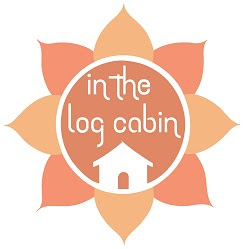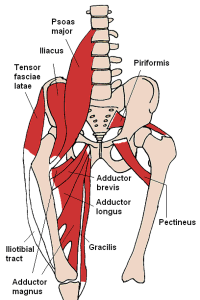
The hip flexor muscles (photo: wikimedia)
What are the Hip Flexors?
The hip flexors are a complex group of muscles which enable us to flex the hip and they connect our legs to our pelvis. They are extremely important muscles and are used when we bring the thigh toward the body, as in lifting the knee, or when the body comes toward the thigh, for example when doing a sit up.
The group of muscles which make up the hip flexors are:
- Iliopsoas (iliacus, psoas major and psoas minor)
- Rectus Femoris
- Tensor Fasciae Latae
- Pectineus
- Sartorius
The Hip Flexors and Pilates
Many of us lead a mostly sedentary lifestyle involving lots of sitting and driving. In time, our hip flexors become short and tight from too much sitting which in turn can lead to lower back pain. Another hazard of overactive hip flexors is that the opposing muscles can become underactive and lengthened, leading to conditions such as sciatica.
It goes without saying that we need our hip flexors! However, we generally don’t need them as much as we use them. The iliopsoas is attached to the spine and is therefore linked with our core muscles. Have you ever found that when you are doing a sit up, your feet come off the mat? Or when rolling down from sitting to lying your feet or legs lift up? When your core muscles are weak, your hip flexors kick in to do some of the work.
Good core strength isn’t just about the ability to do a good sit up though. More importantly it holds our spine in a strong, neutral position allowing the muscles to work evenly.
In Pilates, the exercises target the core muscles and the hip flexors will be working too. The trick is to strengthen the core to prevent the hip flexors doing too much of the work. The first step for this is to become mindful of how the body is working. Focus on your core muscles, keeping the spine in a neutral position and learning how to feel when your hip flexors are starting to overwork.
In addition to strengthening the core muscles, the hip flexors will also need to be stretched out. This combination of increasing core strength and stretching the hip flexors will enable the spine to maintain its neutral position and will decrease back, groin and hip pain.
Three of the best Hip Flexor Stretches
-
Lunging Hip Flexor Stretch – targets the iliopsoas
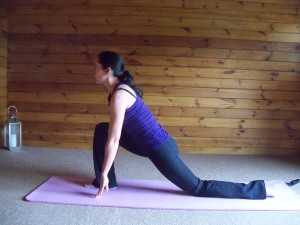
Lunging hip flexor stretch
Begin by coming on to all fours. Ensure the knees are under the hips and hands under the shoulders. Step one foot in between the hands. Slide the other leg behind you. Maintain a neutral spine and engage the core to help keep the pelvis stable. Allow the body to bend to rest the hands on the floor. Ensure that the pelvis is level and that both hips are facing the floor. Make sure that the knee does not come in front of the toes of the bent leg. Engage the glutes by squeezing the buttocks. You will feel the stretch through the front of the thigh of the straightened leg. Hold the stretch for 30 seconds and repeat on the other side. Repeat three times on each side.
-
Kneeling Hip Flexor Stretch – targets the rectus femoris
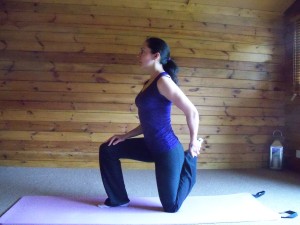
Kneeling hip flexor stretch
Begin by coming on to all fours. Ensure the knees are under the hips and hands under the shoulders. Step one foot in between the hands. Take hold of the ankle of the other leg and draw the ankle toward the buttocks.
Engage the glutes by squeezing the buttocks. Aim to keep the body in an upright position, maintaining neutral spine and engaging the core muscles to support the pelvis. Hold the stretch for 30 seconds and repeat on the other side. Repeat three times on each side. NB you should have a towel or cushion under the knee for comfort.
-
Standing Hip Flexor Stretch – targets the rectus femoris and iliopsoas
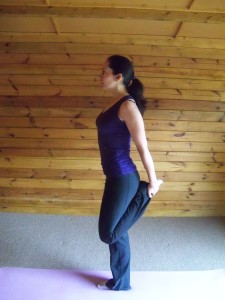 This is a simple stretch which begins by standing and balancing on one leg. Ensure the knee of the supporting leg is soft and not in a locked position. Bend the knee of the non-supporting leg and take hold of the ankle. Draw the ankle toward the buttocks. Engage the glutes by squeezing the buttocks. Keep the hips level and imagine pushing them forwards. Keep the core engaged to support the pelvis and lower back. Hold the stretch for
This is a simple stretch which begins by standing and balancing on one leg. Ensure the knee of the supporting leg is soft and not in a locked position. Bend the knee of the non-supporting leg and take hold of the ankle. Draw the ankle toward the buttocks. Engage the glutes by squeezing the buttocks. Keep the hips level and imagine pushing them forwards. Keep the core engaged to support the pelvis and lower back. Hold the stretch for
30 seconds and repeat on the other side. Repeat three times on each side.
You will find some of these stretches harder than others but have a go at all of them and find one which suits you. Remember to warm up prior to doing any stretches and if at any time you feel pain, stop and try again more gently.
These stretches are beneficial to everyone so go ahead and have a go! If you are a runner or cyclist you may find these particularly useful and they can be done before and after exercise.
